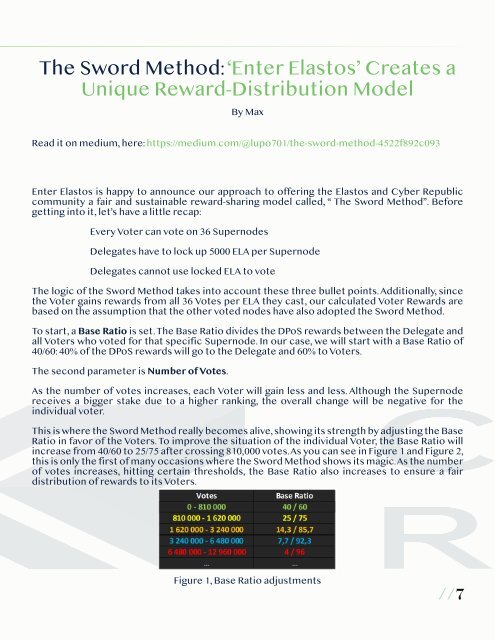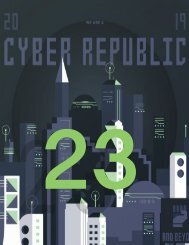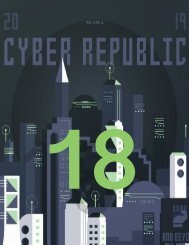Cyber Republic Weekly Update 20
There are several developments for Cyber Republic and Elastos this week: The 12 CRC DPoS nodes are up and running and merged mining is officially open to the public with three of the top 10 BTC mining pools already merged mining ELA this week and mining difficulty increasing six times over in that short period (at the time of this writing). Crypto Insider conducted an engaging interview with Rong Chen about Elastos and the CR . The CR website has a sleek new look. Useful functions have been incorporated in the Suggestion process on the CR website such as autotranslation features has added Elastos to its Trello development page. Kiran Pachhai (KP) has come out with another Spotlight Series article, this time on DPoS Consensus and Block Finality. Kiran has also posted a video on the new Private net on YouTube. There is a new proposal that has been approved to develop a browser plug-in for Elastos wallet. And that’s not all. In this Weekly we have an article on a new Elastos Foundation team called, “The Developer Experience Team”, a unique reward system called the “Sword Method” proposed by Supernode Candidate Enter Elastos, a Suggestions Highlight for a project called “Arkane”, several more Supernode candidates, an interview with an exciting team called “AllianceBlock”, and updates from our family in the Philippines. Phew! Without further ado, let’s get into it.
There are several developments for Cyber Republic and Elastos this week: The 12 CRC DPoS nodes are up and running and merged mining is officially open to the public with three of the top 10 BTC mining pools already merged mining ELA this week and mining difficulty increasing six times over in that short period (at the time of this writing). Crypto Insider conducted an engaging interview with Rong Chen about Elastos and the CR . The CR website has a sleek new look. Useful functions have been incorporated in the Suggestion process on the CR website such as autotranslation features has added Elastos to its Trello development page. Kiran Pachhai (KP) has come out with another Spotlight Series article, this time on DPoS Consensus and Block Finality. Kiran has also posted a video on the new Private net on YouTube. There is a new proposal that has been approved to develop a browser plug-in for Elastos wallet. And that’s not all. In this Weekly we have an article on a new Elastos Foundation team called, “The Developer Experience Team”, a unique reward system called the “Sword Method” proposed by Supernode Candidate Enter Elastos, a Suggestions Highlight for a project called “Arkane”, several more Supernode candidates, an interview with an exciting team called “AllianceBlock”, and updates from our family in the Philippines. Phew! Without further ado, let’s get into it.
You also want an ePaper? Increase the reach of your titles
YUMPU automatically turns print PDFs into web optimized ePapers that Google loves.
The Sword Method:‘Enter Elastos’ Creates a<br />
Unique Reward-Distribution Model<br />
By Max<br />
Read it on medium, here: https://medium.com/@lupo701/the-sword-method-4522f892c093<br />
Enter Elastos is happy to announce our approach to offering the Elastos and <strong>Cyber</strong> <strong>Republic</strong><br />
community a fair and sustainable reward-sharing model called, “ The Sword Method”. Before<br />
getting into it, let’s have a little recap:<br />
Every Voter can vote on 36 Supernodes<br />
Delegates have to lock up 5000 ELA per Supernode<br />
Delegates cannot use locked ELA to vote<br />
The logic of the Sword Method takes into account these three bullet points. Additionally, since<br />
the Voter gains rewards from all 36 Votes per ELA they cast, our calculated Voter Rewards are<br />
based on the assumption that the other voted nodes have also adopted the Sword Method.<br />
To start, a Base Ratio is set.The Base Ratio divides the DPoS rewards between the Delegate and<br />
all Voters who voted for that specific Supernode. In our case, we will start with a Base Ratio of<br />
40/60: 40% of the DPoS rewards will go to the Delegate and 60% to Voters.<br />
The second parameter is Number of Votes.<br />
As the number of votes increases, each Voter will gain less and less. Although the Supernode<br />
receives a bigger stake due to a higher ranking, the overall change will be negative for the<br />
individual voter.<br />
This is where the Sword Method really becomes alive,showing its strength by adjusting the Base<br />
Ratio in favor of the Voters. To improve the situation of the individual Voter, the Base Ratio will<br />
increase from 40/60 to 25/75 after crossing 810,000 votes.As you can see in Figure 1 and Figure 2,<br />
this is only the first of many occasions where the Sword Method shows its magic.As the number<br />
of votes increases, hitting certain thresholds, the Base Ratio also increases to ensure a fair<br />
distribution of rewards to its Voters.<br />
Figure 1, Base Ratio adjustments<br />
//7
















